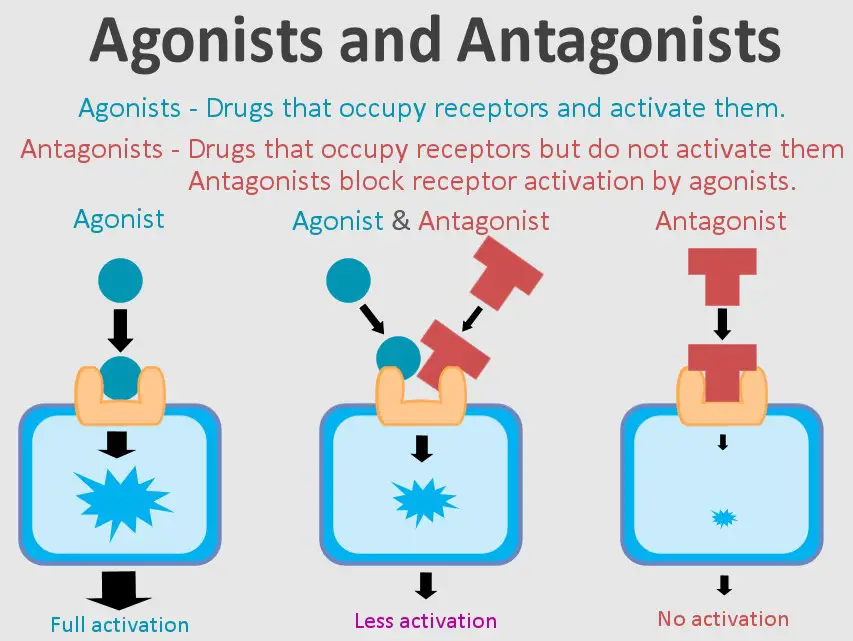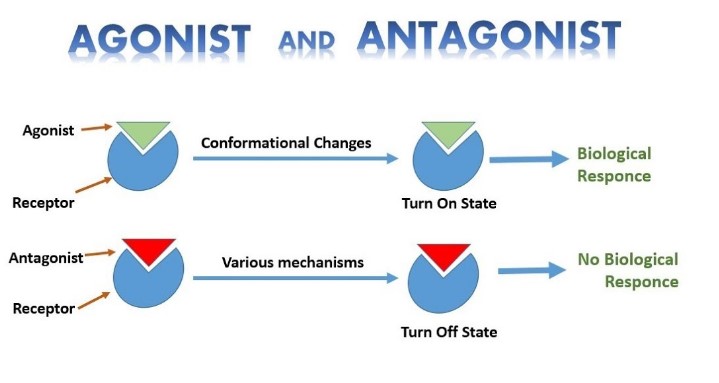In the world of medicine, two key terms that are often discussed are agonist and antagonist drugs. While they may sound similar, these two drugs actually have very distinct differences.
In this blog post, we will explore the difference between agonist and antagonist drugs and how they are used in medical treatments.
Differences between agonist and antagonist drugs

Agonist and antagonist drugs act in different ways to modify the effects of neurotransmitters in our bodies. Agonist drugs increase the activity of a particular neurotransmitter, while antagonist drugs decrease the activity of that same neurotransmitter. Agonists tend to increase the amount of dopamine, serotonin, and other neurotransmitters released into the brain, while antagonists tend to reduce the amount of these neurotransmitters released.
Although the two types of drugs have different effects, they both ultimately aim to regulate our moods and behaviors in some way. Agonists can be used to treat conditions such as depression and anxiety, while antagonists are used to treat conditions such as schizophrenia and addiction.
Ultimately, the difference between agonist and antagonist drugs lies in their effects on the neurotransmitters in our bodies.
Types of agonist and antagonist drugs

Agonist and antagonist drugs are two distinct types of pharmaceuticals that have very different effects on the body. An agonist drug activates a receptor in the body to produce a specific response, while an antagonist drug inhibits or blocks the action of the receptor. Both types of drugs can be used to treat a wide range of conditions, depending on the intended outcome of the treatment.
Both types of drugs can be used to treat a wide range of conditions, depending on the intended outcome of the treatment. Agonist drugs are often used to treat conditions such as anxiety or depression, while antagonist drugs are used to treat conditions such as nausea or hypertension. The difference between agonist and antagonist drugs lies in how they interact with receptors in the body.
Agonist drugs activate the receptor, while antagonist drugs block or inhibit the receptor from responding. This makes agonist drugs suitable for treatments that require activation of a receptor, while antagonist drugs are better suited for treatments that require blocking the activity of a receptor.
Factors to consider when choosing between agonist and antagonist drugs

When it comes to choosing between agonist and antagonist drugs, there are a few key factors to consider. Agonist drugs bind to receptors and activate them, resulting in physiological changes in the body. On the other hand, antagonist drugs bind to receptors and block them, preventing any physiological changes.
Depending on the desired outcome, one of these drugs may be more appropriate. Additionally, it is important to consider the type of receptor a drug will be targeting, as well as its effectiveness and side effects.
Ultimately, it is important to weigh the pros and cons of agonist vs antagonist drugs in order to choose the best option for the individual.
Side effects associated with agonist and antagonist drugs

Agonist and antagonist drugs are two different types of medications that work in opposite ways to treat a variety of medical conditions. Agonist drugs stimulate a response in the body’s cells, while antagonist drugs block a certain response.
Both types of drugs can have side effects, but they are usually different depending on how the drug works. Agonist drugs can cause increased heart rate, increased blood pressure, and increased alertness, while antagonist drugs can cause drowsiness, dry mouth, and constipation. It is important to understand the differences between these two drug types and the potential side effects they can cause.
Uses of agonist and antagonist drugs

The use of agonist and antagonist drugs is a key factor in modern medicine. Agonists are drugs that activate receptors in the body, triggering a response, while antagonists are drugs that bind to receptors and prevent them from being activated. Both can be used in combination to achieve desired results.
Both can be used in combination to achieve desired results. For example, agonists may be used to increase the level of certain neurotransmitters in the body, while antagonists can be used to block the action of certain hormones. This can be used to treat conditions such as depression, anxiety and even cancer.
It is important to understand the difference between agonists and antagonists in order to understand how they work and how they should be used.
Summary and conclusion

The difference between agonist and antagonist drugs can be a bit confusing, but in general, agonists are drugs that bind to and activate receptors, while antagonists are drugs that block or inhibit the action of receptors. Agonists work by mimicking a specific natural substance and stimulating a response, while antagonists work by preventing the action of the natural substance. Agonists can produce effects in the body that are similar to the natural substances they mimic, while antagonists typically produce no effect on the body, but instead block the action of the natural substances.
Agonists can produce effects in the body that are similar to the natural substances they mimic, while antagonists typically produce no effect on the body, but instead block the action of the natural substances. Ultimately, agonists and antagonists work in tandem to produce a desired effect in the body, and understanding the differences between them can help to ensure proper use of these drugs.
Final Touch
In conclusion, agonist and antagonist drugs are two different types of drugs that have different functions. Agonist drugs are those that activate or stimulate certain receptors, while antagonist drugs are those that block or inhibit certain receptors.
Agonist drugs are typically used to treat a variety of medical conditions such as pain and depression, while antagonist drugs are often used to help manage side effects or counteract the effects of other drugs. Each type of drug has its own set of benefits and risks, and it is important to consult with a doctor before taking either type of medication.

